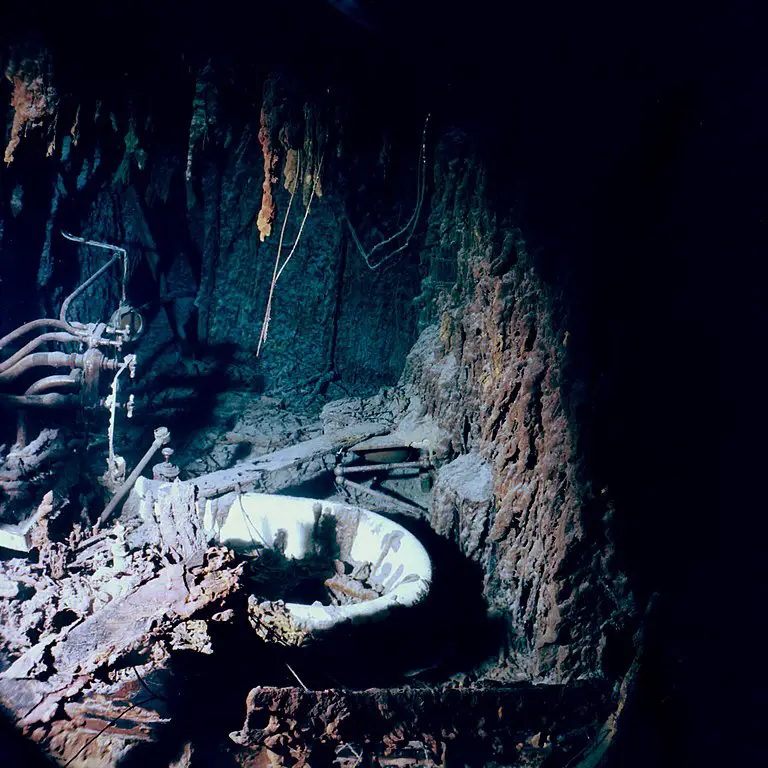The RMS Titanic, one of history’s most tragic maritime disasters, continues to fascinate the world with the remnants discovered at its wreck site. Among these relics, the bathtub in Captain Edward Smith’s private cabin stands out as one of the most well-preserved artifacts from the sunken ship. Over a century after the ship sank on its maiden voyage in 1912, this simple yet symbolic object has become a key focus of deep-sea exploration and Titanic studies.
Table of Contents
ToggleA Marvel of Early 20th Century Innovation
Captain Edward Smith’s cabin, located in the ship’s officers’ quarters, was designed with every luxury of the era. The bathtub, constructed from porcelain, featured a state-of-the-art plumbing system that allowed for both freshwater and seawater—a luxury that was considered quite advanced at the time. Such conveniences were indicative of the Titanic’s grandeur, symbolizing the pinnacle of technological achievement aboard the vessel.

The fact that Captain Smith’s cabin had access to both types of water highlighted the importance placed on his personal comfort and the high standards of the time for the elite passengers and crew members. In an era where indoor plumbing was still a novel concept for many, the presence of such advanced features reflected the Titanic’s status as the most luxurious liner ever built.
Remarkable Preservation Despite a Century Underwater
Since the discovery of the Titanic wreck in 1985, the bathtub has drawn considerable attention due to its remarkable preservation. Although the rest of the ship has experienced extensive damage, from corrosion to marine life slowly consuming its iron structure, the bathtub remains largely intact. The plumbing, the design, and even parts of the surrounding room are still visible, offering an eerie snapshot of life aboard the ill-fated ship.
The tub has become a powerful reminder of how even in the depths of the Atlantic, certain parts of human creation withstand the test of time. This is particularly poignant when contrasted with the rest of the wreckage, which has been heavily affected by rusticles, bacteria that feed on the ship’s metal. While most of the Titanic has slowly decayed, the bathtub’s persistence suggests that some aspects of the ship’s craftsmanship were truly built to last.
A Symbol of Loss and Historical Fascination
While the bathtub is a relatively simple object, it has come to represent much more in the narrative of the Titanic. Its endurance amid the surrounding decay serves as a stark contrast to the tragic loss of life that occurred when the ship sank, taking over 1,500 souls to their watery graves. The bathtub’s survival underscores the haunting reality of the wreck site: a place frozen in time, where personal items, once symbols of luxury and innovation, now lie abandoned on the ocean floor.

For many researchers and enthusiasts, the bathtub has become a symbol of the tragedy’s human element. It offers a glimpse into the daily life of Captain Smith, who perished along with the ship he commanded, and serves as a reminder of the personal stories that unfolded aboard the Titanic. The preservation of this intimate detail of Smith’s cabin adds depth to the broader historical understanding of the ship and its passengers.
The Future of the Wreck
Despite the relative preservation of some items, the Titanic wreck is gradually deteriorating. Experts believe that rusticles and other underwater forces will eventually consume what remains of the vessel. The bathtub, along with other artifacts, may one day disappear entirely. For now, however, it remains an enduring symbol of the Titanic’s legacy—both a testament to early 20th-century engineering and a poignant reminder of the human cost of the ship’s tragic sinking.

As ongoing explorations and documentaries continue to highlight the wreck, Captain Smith’s bathtub remains one of the most intriguing and iconic images from the site. It stands as a testament to the fascination surrounding the Titanic, a ship that continues to captivate the world more than a century after it met its fateful end.
Conclusion
The bathtub in Captain Edward Smith’s cabin represents more than just a preserved artifact from the wreck of the Titanic—it stands as a symbol of the ship’s grandeur, technological advancements, and the enduring human stories connected to the disaster. While much of the ship has succumbed to the ocean’s forces, this simple relic serves as a tangible link to the past, offering insights into the luxury and tragedy that defined the Titanic‘s legacy.

